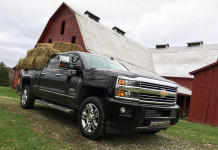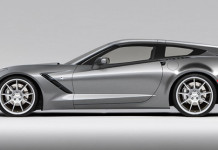Less weight, more power; it’s the eternal mantra of millions of gear heads the world over. While many automakers do well with more power end of things, very few are able to effectively combat the weight like Chevrolet has done with the Corvette. For 60 years, the Corvette has been advancing the technology of lightweight construction in the pursuit of world-beating performance.
America’s sports car began its journey to weight supremacy in 1953 with the very first Corvette. The 1953 Corvette featured the world’s first production all fiberglass body. Since that first Corvette was assembled, every corvette since has been comprised of some type of composite, whether it be fiberglass or otherwise.
In 1973 the Corvette began production with a sheet-molded composite (SMC), thanks to advancements in production techniques. SMC has allowed engineers to adjust the material composition over the years to create thinner and lighter panels while maintaining strength. Many of the advancements over the years of the Corvette came to completion with the fifth generation Corvette, the C5.
Released in 1997, the C5 was both longer and wider than the C4 but still weighed about 100-pounds less. The body panels may be exceptionally light, but the weight-obsession was not limited to body work. The new chassis of the C5 used hydroformed sections to provide strength with less weight and complexity, and the floor boards are made with a sandwich of materials including feather-light balsa wood. The engine of the corvette was also put on a diet, thanks to the introduction of GM’s Gen III small-block which is made of aluminum instead of the older Gen II’s iron block. The C5 was also the first Corvette to include Carbon fiber and titanium. In 2001 the high performance Corvette Z06 was introduced and featured a titanium exhaust system. At 26-pounds it was 70-percent lighter than the conventional system. In 2004 a special edition Z06 was released with a carbon fiber hood that weighed 11-pounds less than the already light SMC hood on the standard car.
When the newest Corvette, the C6, debuted in 2005 it was clear that GM was not afraid of using advanced materials to keep weight down. In 2006 the new Z06 was introduced with an aluminum based chassis and an even greater use of carbon fiber in the body work, including front and rear fenders and the front wheel houses. Magnesium alloys have also been integrated into the engine cradle, some suspension components and the roof structure to help reduce mass.
When the ZR1 was introduced it pushed the use of advanced materials even farther than the Z06 with more carbon fiber in the roof and rocker panels, plus the addition of carbon ceramic brakes rotors. While these space-age components carry a price penalty, they offer incredible weight savings and exceptional wear resistance.
“Corvette has never been focused on an exclusive material – be it aluminum, carbon fiber, or fiberglass,” said Corvette Executive Chief Engineer Tadge Juechter. “Instead, we are constantly looking for the best materials structure, powertrain, and chassis to improve the performance of Corvette.”
While the accomplishments of the Corvette team over the last 60 years is nothing short of astounding, the new C7 corvette is just around the corner, and we expect to see even more advancements in the pursuit of lightness.










